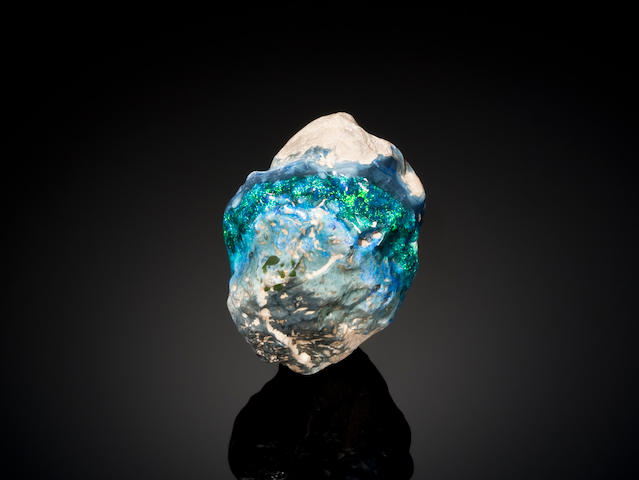Posted in: Birthstones
 Halley's Comet Opal, the largest recorded fine black opal nodule. Photo copyright Bonham's Auctions, 2013.
The Halley's Comet Opal remains one of the world's largest uncut black opal nodules ever found. Recorded in 1991, in the Guinness Book of World Records, the exquisite opal specimen measures 4 x 2-5/8 x 2-1/2 inches, weighing 1982.5 carats. In December 2013, Bonhams Auction house offered the legendary opal for auction in Los Angeles.
Halley's Comet Opal, the largest recorded fine black opal nodule. Photo copyright Bonham's Auctions, 2013.
The Halley's Comet Opal remains one of the world's largest uncut black opal nodules ever found. Recorded in 1991, in the Guinness Book of World Records, the exquisite opal specimen measures 4 x 2-5/8 x 2-1/2 inches, weighing 1982.5 carats. In December 2013, Bonhams Auction house offered the legendary opal for auction in Los Angeles.
Halley's Comet Opal
Bonhams described the opal as an internationally recognized fine-quality specimen of black opal. The nodule features a thick black gem-grade opal color bar which measures approximately one inch at its widest point. (source) Perfectly centered in the nodule, this band of black opal presents a floral, harlequin pattern featuring green, yellow, and blue-violet swatches of color. This color band perfectly centers the fist-sized globe of opal.A Legend For Sale
As I mentioned, in 2013 Bonhams auctioned the legendary gem with an estimated price of $450K - $650K. They encouraged serious collectors to take note of this once-in-a-lifetime opportunity to purchase the stone at auction. Indeed, in 2006, a private dealer offered it at a price of $1.2 million. Unearthed on November 3, 1986, Halley's Comet took its name from the comet of the same name, which happened to zip by in the sky over Australia on the same night. The five miners who found her collectively call themselves the Lunatic Hill Syndicate. They operate the Leaning Tree Claim in the 3-Mile Opal Field at Lightning Ridge in Australia.Lunatic Hill
The Leaning Tree Claim finds itself situated in a shallow flat below a hill. Gougers working the claim considered anyone ready to climb up the hill, only to sink all the way down to opal levels, a complete lunatic. Most of the miners in the region found the black opals discovered more easily at 2 to 5 meters down sufficient. Indeed, most wrote off the hillside, believing it a lost cause. However, one lone miner strayed off the usual course and tried his luck with the hillside. Digging a shaft 20 meters down, he discovered some of the most beautiful specimens of black opal ever mined in Australia. From then on, old timers called the hillside Lunatick Hill. Indeed, the Halley's Comet Opal surfaced at a depth of 20 meters on this same hillside. At this location, using mining equipment, miners dredge up hundreds of thousands of cubic meters of dirt. Once its pulled to the surface, they place all the dirt into an agitator, a converted concrete mixer. Once washed, the miners retrieve the gem-quality opals. In the case of Halley's Comet, 100,000 cubic meters of dirt yielded a number of opals ranging in size between 10 and 80 carats, plus the 2000-carat giant. As for the results of the auction in 2013, the beautiful specimen failed to sell. The current whereabouts of the Halley's Comet Opal remain obscure to me at this time. ~Angela Magnotti Andrews5 years ago
2 view(s) 